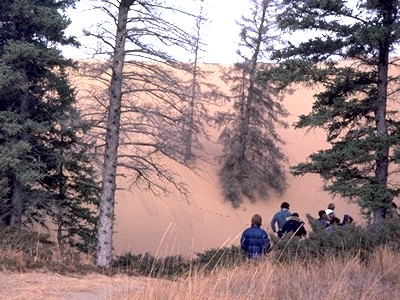
The Northern Prairie Skink
| By Errol J. Bredin |
The Carberry Sandhills are, to me, a mystic, mysterious, sacred place. That opinion has been formulated from over 40 years of wandering over the undulating, wild terrain. It is an opinion formulated slowly, after standing alone, countless times, on a high ridge watching the crimson sunrise streaked with ribbons of gold, the mixed-grass prairie behind me, dew laden and aglow, the large tamarack bog below me enshrouded in ethereal mists, all quiet in the pre-dawn hush.
 Many times while gazing over such a spectacular panorama I've
tried to imagine what it was like in the beginning. Some twenty
thousand years ago Manitoba lay under a thick sheet of ice. Fifteen
thousand years ago a warming trend was well underway, the great
ice-sheet receded, and the massive amounts of melt water formed
glacial Lake Agassiz. The Assiniboine River was a raging torrent
pouring into Lake Agassiz on its western shore. The sand, gravel,
and silt carried by the river slowly formed an immense fan-shaped
delta covering some 6500 sq. km. About eight thousand years ago
the delta emerged well above the level of Lake Agassiz as a continued
warming trend shrank the great waters back to what we now know
as Lake Winnipegosis, Lake Winnipeg, and Lake Manitoba.
Many times while gazing over such a spectacular panorama I've
tried to imagine what it was like in the beginning. Some twenty
thousand years ago Manitoba lay under a thick sheet of ice. Fifteen
thousand years ago a warming trend was well underway, the great
ice-sheet receded, and the massive amounts of melt water formed
glacial Lake Agassiz. The Assiniboine River was a raging torrent
pouring into Lake Agassiz on its western shore. The sand, gravel,
and silt carried by the river slowly formed an immense fan-shaped
delta covering some 6500 sq. km. About eight thousand years ago
the delta emerged well above the level of Lake Agassiz as a continued
warming trend shrank the great waters back to what we now know
as Lake Winnipegosis, Lake Winnipeg, and Lake Manitoba.
The author with "Peeper", an orphaned kestrel. |
For a considerable time this delta was a barren mass of shifting sands, devoid of vegetation. Seasonal winds howled across its surface heaving up massive dunes. Slowly, white spruce, tamarack, and juniper established themselves creating the unique boreal forest habitat that exists today. Mixed grasses, wildflowers, and shrubs took hold and finally the deciduous forest cover of bur oak and groves of aspen poplar.
 This once barren delta is now known as the Carberry Sandhills.
The only remnants of the past, shifting sands is a rapidly vegetating
portion of the Shilo military training range and Spirit Sands
in Sprucewoods Provincial Park. Overall the landscape may appear
lush but the once rolling dunes are covered by a fragile topsoil
only a few centimeters thick. This delicate carpet has cushioned
the footsteps of many avid naturalists. The distinguished Criddles
of Aweme wandered these hills studying many facets of the diverse
ecology. The world-renowned naturalist, artist, and writer, Ernest
Thompson Seton, drew from these hills the inspirations for one
of his best known works: "The Trail of the Sandhill Stag".
This once barren delta is now known as the Carberry Sandhills.
The only remnants of the past, shifting sands is a rapidly vegetating
portion of the Shilo military training range and Spirit Sands
in Sprucewoods Provincial Park. Overall the landscape may appear
lush but the once rolling dunes are covered by a fragile topsoil
only a few centimeters thick. This delicate carpet has cushioned
the footsteps of many avid naturalists. The distinguished Criddles
of Aweme wandered these hills studying many facets of the diverse
ecology. The world-renowned naturalist, artist, and writer, Ernest
Thompson Seton, drew from these hills the inspirations for one
of his best known works: "The Trail of the Sandhill Stag".
Because of the large deposits of deltaic sands, in places 60m deep, relics of the past, more temperate periods, have survived and in this unique environment can still withstand harsh Manitoba winters by burrowing easily below frost lines. Present in these hills are the Western Hognose Snake (Heterodon nasicus), the Plains Spadefoot Toad (Scaphiopus bombifrons), and the Northern Prairie Skink (Plestiodon septentrionalis).
Carry on for More about the Northern Prairie Skink!![]()
| You can help NatureNorth produce more great articles with a secure donation through PayPal. Our Google Adsense ads pay our server costs, but that's about it. To learn more follow this link: Support NatureNorth. Thank-you! | |
Return to: Summer Issue | NatureNorth Front page
